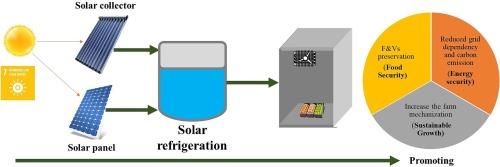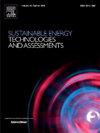用于农场水果和蔬菜保鲜的太阳能制冷系统和储能方法的最新发展情况
IF 7.1
2区 工程技术
Q1 ENERGY & FUELS
Sustainable Energy Technologies and Assessments
Pub Date : 2024-10-19
DOI:10.1016/j.seta.2024.104032
引用次数: 0
摘要
发展中国家为实现可持续发展,对粮食和能源安全有着强烈的需求。太阳能制冷系统(SRS)为减少水果和蔬菜(F&V)损失以及应对能源和环境挑战提供了重要的解决方案。太阳能制冷系统具有分散果蔬保鲜冷藏作业的潜力,可显著减少碳足迹。本文旨在介绍不同太阳能制冷技术的基本概念和原理,以及用于 F&V 保鲜的生态友好型储能方法。它详细回顾了过去在太阳能制冷系统、开发和应用于 F&V 储存方面所做的努力。本研究综述了太阳能制冷系统领域的各种研究文章,以及将其与冷热蓄能(CTES)集成用于 F&V 保鲜的性能研究报告。太阳能蓄冷系统分为太阳能热系统、太阳能蒸发系统和太阳能电制冷系统。采用太阳能蓄冷系统可使食品和饮料保鲜过程中的二氧化碳排放量减少 0.784 0.784 KgCO2/kWh。与其他系统相比,太阳能光伏蒸气压缩系统简单,维护要求低,COP 值高。此外,太阳能热电、蒸发和单效吸收系统的 COP 小于 1。冷热能储存与太阳能制冷系统(SRS)的整合将成为下一代备用电池的替代品,它具有以低成本和净零碳排放为基础的 F&V 储存系统运行的潜力。CTES 可分为潜热和显热储能。潜热储能系统储存的冷能是显热储能系统的 10-15 倍。本文章由计算机程序翻译,如有差异,请以英文原文为准。

Recent developments in solar-powered refrigeration systems and energy storage methods for on-farm preservation of fruits and vegetables
There is a strong demand for food and energy security to attain sustainable development in developing countries. Solar refrigeration systems (SRS) offer a crucial solution for reducing fruit and vegetable (F&V) loss and addressing energy and environmental challenges. SRS has the potential to decentralize cold storage operations for F&V preservation, significantly reducing the carbon footprint. This paper aims to provide the fundamental concept and principle of different solar refrigeration technologies and eco-friendly energy storage methods for F&V preservation. It presents a detailed review of past efforts on solar cooling systems, development, and application for F&V storage. This study reviews various research articles in the field of solar cooling systems and their integration with cold thermal energy storage (CTES) performance studies for F&V preservation reported. Solar cold storage systems are classified into solar thermal, solar evaporative, and solar electric refrigeration systems. SRS adoption can prevent the CO2 emission rate by 0.784 0.784 KgCO2/kWh during F&Vs preservation. Solar PV vapour compression systems are simple, require less maintenance, and present higher COP than other. Additionally, Solar thermoelectric, evaporative, and single-effect absorption systems presented COP less than 1. The integration of cold thermal energy storage with a solar refrigeration system (SRS) will be the next-generation alternative for battery-based backup, which has the potential to run the system at low cost and net-zero carbon emission-based F&V storage. CTES is classified into latent and sensible heat-based energy storage. Latent heat storage systems store cold energy 10–15 times greater than sensible heat storage systems.
求助全文
通过发布文献求助,成功后即可免费获取论文全文。
去求助
来源期刊

Sustainable Energy Technologies and Assessments
Energy-Renewable Energy, Sustainability and the Environment
CiteScore
12.70
自引率
12.50%
发文量
1091
期刊介绍:
Encouraging a transition to a sustainable energy future is imperative for our world. Technologies that enable this shift in various sectors like transportation, heating, and power systems are of utmost importance. Sustainable Energy Technologies and Assessments welcomes papers focusing on a range of aspects and levels of technological advancements in energy generation and utilization. The aim is to reduce the negative environmental impact associated with energy production and consumption, spanning from laboratory experiments to real-world applications in the commercial sector.
 求助内容:
求助内容: 应助结果提醒方式:
应助结果提醒方式:


